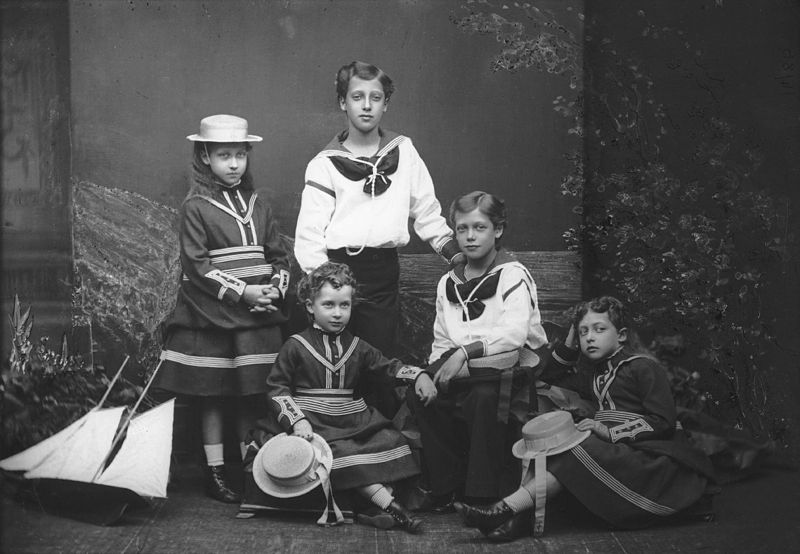by Susan Flantzer © Unofficial Royalty 2014

Princess Victoria of the United Kingdom; Credit – Wikipedia
Princess Victoria was born on July 6, 1868, at Marlborough House, near Buckingham Palace, in London, England, the second daughter and the fourth of the six children of the future King Edward VII of the United Kingdom and his wife Alexandra of Denmark. Her full name was Victoria Alexandra Olga Mary and she was known as Toria in the family. At the time of her birth, she was styled Princess Victoria of Wales, as her father was Prince of Wales. When her father became king, she was then styled Her Royal Highness The Princess Victoria.
When Toria was christened on August 6, 1868, at Marlborough House, her parents’ London home, she had a large and impressive group of godparents, most of whom had a proxy standing in for them:
- Queen Victoria, her paternal grandmother
- Alexander II, Emperor of All Russia
- Tsarevich Alexander Alexandrovich of Russia, her maternal uncle by marriage, the future Alexander III, Emperor of All Russia
- Prince Ludwig of Hesse and by Rhine, her paternal uncle by marriage, the future Grand Duke Ludwig IV of Hesse-Darmstadt
- Prince George of Hesse-Kassel
- Queen Olga of Greece, her maternal aunt by marriage, born Grand Duchess Olga Konstantinovna of Russia
- Caroline Amalie, Dowager Queen of Denmark, born Caroline Amalie of Schleswig-Holstein-Sonderburg-Augustenburg
- Marie, Dowager Duchess of Mecklenburg-Strelitz, (born Marie of Hesse-Kassel)
- Princess Mary Adelaide of Cambridge, Duchess of Teck, her first cousin twice removed
- Princess Frederick of Anhalt (her maternal great-aunt, born Marie Luise Charlotte of Hesse-Kassel)
Toria had five siblings:
- Prince Albert Victor, Duke of Clarence and Avondale (1864 – 1892), unmarried
- King George V (1865 – 1936), married 1893 Princess Mary of Teck; had issue
- Princess Louise, Princess Royal (1867 – 1931), married 1889 Alexander Duff, 1st Duke of Fife; had issue
- Princess Maud (1869 – 1938), married 1896 King Haakon VII of Norway; had issue
- Prince Alexander John (April 6, 1871 – April 7, 1871)
Toria was brought up with her elder sister Louise and her younger sister Maud. None of the sisters had inherited the good looks of their mother and as a result, the three sisters were very shy. Their mother Alexandra was extremely possessive, demanded complete devotion from her children, and insisted that they call her Motherdear. Louise and Maud escaped into marriage, leaving Toria at home as her mother’s constant companion. Toria had several suitors including Prince Adolphus of Teck, Sir Arthur Davidson, one of her father’s equerries, and Archibald Primrose, 5th Earl of Rosebery. Lord Rosebery was a former Prime Minister who had been widowed, and both he and Toria would have liked to have married. However, Toria’s mother actively discouraged her from marrying anyone. Instead, Toria remained a companion to her mother, Queen Alexandra, whom she lived with until the Queen died in 1925. Grand Duchess Olga Alexandrovna, Toria’s first cousin, described her as little more than “a glorified maid.”
When her mother died, Toria was 57 and was able to live her own life at last. She purchased a country home, Coppins, in Iver, Buckinghamshire, England. Toria became active in the village life of Iver and was the honorary president of the Iver Horticultural Society. When she died, she left Coppins to her nephew Prince George, Duke of Kent and it was sold by his elder son in 1972.
Toria’s last years were plagued with health issues and she suffered from neuralgia, migraines, indigestion, depression, colds, and influenza. Princess Victoria died at her home Coppins on December 3, 1935. Initially interred at St. George’s Chapel at Windsor Castle, she was buried on January 8, 1936, at the Royal Burial Ground at Frogmore near Windsor Castle. Her brother King George V, who was very close to his sister, wrote in his diary, “No one ever had a sister like her.” Her brother did not survive her long. He died on January 20, 1936.
This article is the intellectual property of Unofficial Royalty and is NOT TO BE COPIED, EDITED, OR POSTED IN ANY FORM ON ANOTHER WEBSITE under any circumstances. It is permissible to use a link that directs to Unofficial Royalty.
























